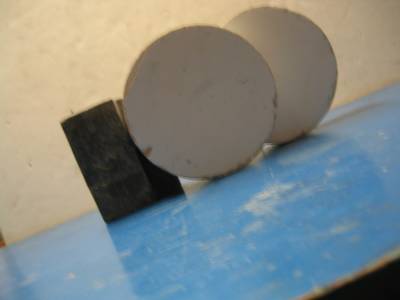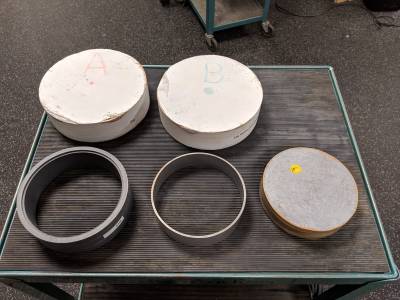demonstrations:1_mechanics:1q_rotational_dynamics:rotational_inertia:start
Table of Contents
Rotational Inertia
Description
This demonstration is run with a pair of inclined planes and a flat surface. A number of objects such as hoops, disks with differing mass distributions, and food containers with different internal composition are used.
Purpose
To compare the rotational inertia of a hoop and a disc of equal masses and radii, and to illustrate how the internal makeup of an object impacts the distance it may roll and the time it takes for it to do so.
Apparatus
- 2 inclined boards and a smooth table
- 2 sets of hoops and discs (pictured below)
- various tins of food of similar radius (optional)
Setup
To set up the inclined boards, place them opposite each other so that an object rolling between them will oscillate.
- Two white wooden discs are supplied with the same mass but a different distribution of mass. These should be released at the same time from the top of one half of the slope. As they roll backwards and forwards on the inclined boards one moves noticeably faster than the other. The probable distribution of mass of these two can be discussed. Now use the brass hoop and the brass disc of equal mass and show that the velocity and acceleration on the slope is greater for the disc than for the hoop.
- When rolled down one plane and along a flat table, friction dissipates the original potential energy so that the distance rolled is an approximate measure of energy. The two white discs (and the brass hoop and disc) should therefore show different velocities but the same stopping point. It is instructive to roll a tin of jam (say) and a tin of soup down the inclined frame (with labels covered?). The thin soup tends NOT to rotate initially so that the jam moves faster but the final stopping distance can show a dramatic difference. The soup finally rotating in the can dissipates energy rapidly so that the soup can stops quickly.
Notes
demonstrations/1_mechanics/1q_rotational_dynamics/rotational_inertia/start.txt · Last modified: by demoroom


